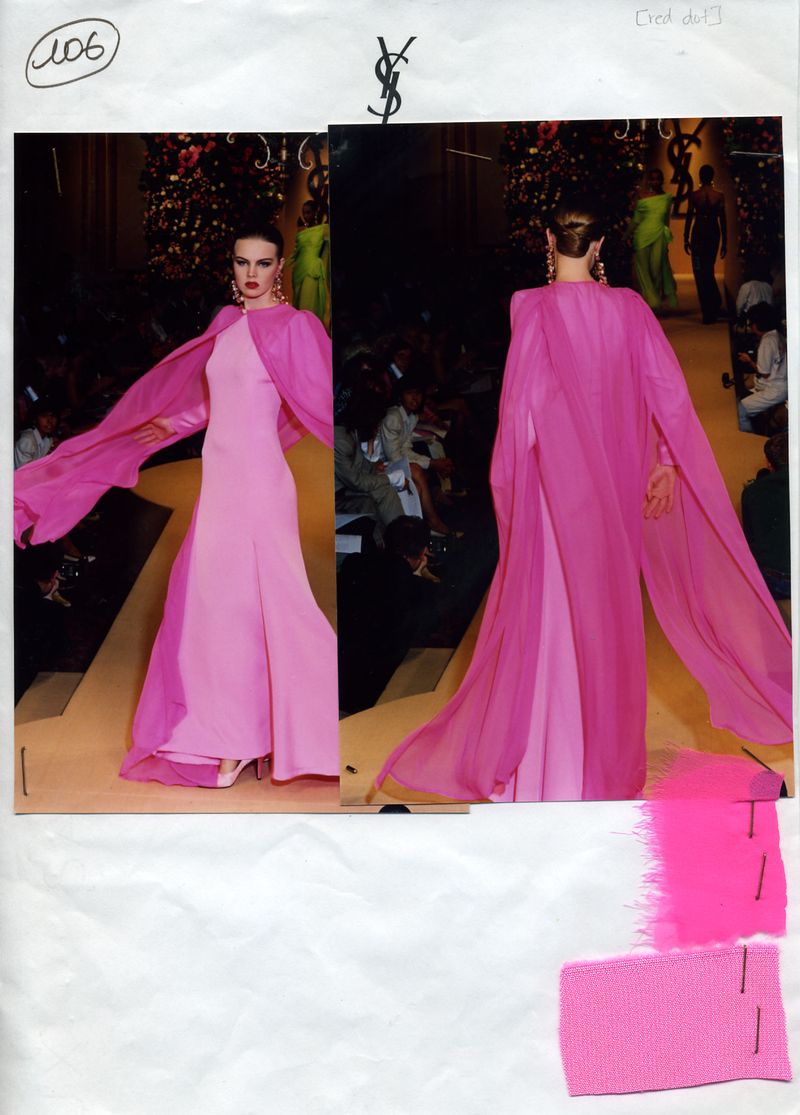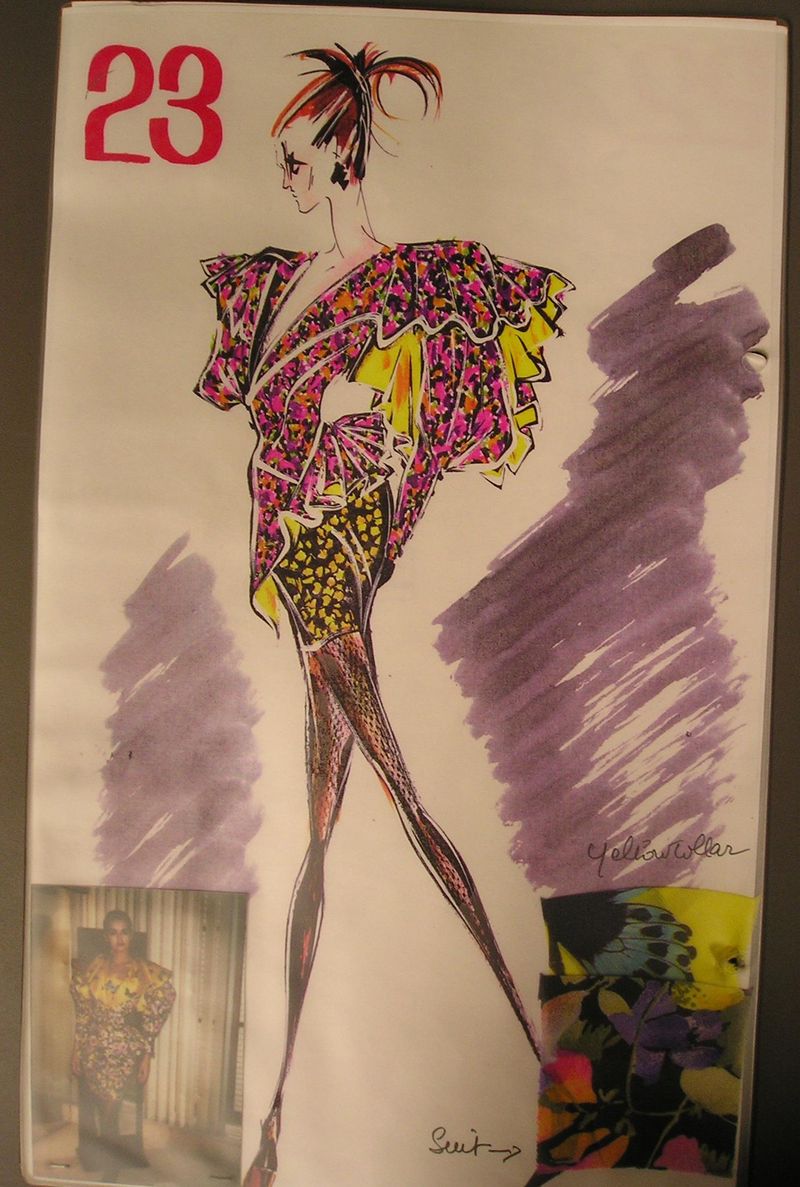Preserving the Ann Getty Fashion Collection
Behind every great museum is a great library. The FIDM Museum is fortunate to have access to the FIDM Library, which houses a great collection of design-oriented books. Today's post focuses on a preservation project completed by Rachel Clarke, FIDM Library Catalog Coordinator. It is a shorter version of an article published in the Spring/Summer 2009 issue of the American Archivist. Congratulations Rachel!
This blog has highlighted many garments from the FIDM Museum Collection, showcasing their value as primary source materials that reveal minute details of design and construction. Often, however, individual garments lack contextual information necessary to interpret their significance as fashion in society and history. In addition to garments themselves, researchers often turn to other resources to document fashion, such as literature, drawings, photographs, magazine articles and ads, among many other sources that offer insight. At FIDM, these paper-based documents generally are collected by the Library, while the Museum collects, conserves, displays, and interprets garments, textiles, and other realia. But what happens when a collection combines paper and textile materials? When fashion designers develop collections and lines, many produce look books, photos, sketches, technical drawings, swatch books, spec sheets, and other materials intended to showcase and market the fashions, while also supporting their manufacture. Many times, these materials are juxtaposed to demonstrate design concepts. Swatches are stapled to photographs which are then taped to sketches. Ann Getty donated such a collection to the FIDM Library in 1993, containing materials from noteworthy designers created between 1973 and 1993. The Ann Getty Fashion Collection contained typed and handwritten paper documents, color and black-and-white sketches (both originals and reproductions), black-and-white and color photographs, and fabric swatches from Pierre Balman, Pierre Cardin, Christian Dior, Galanos, Givenchy, Betsey Johnson, Donna Karan, Anne Klein, Calvin Klein, Christian LaCroix, Lapidus, Hanae Mori, Nina Ricci, Yves Saint Laurent, Mila Schon, Emanuel Ungaro, Valentino and other notable designers. Each designer and house presented design ideas in a unique way. Some simply combined materials loosely in a folder, while others taped, stapled, pinned, or glued fabric swatches to photographs and sketches. Some suggested materials of special interest to Mrs. Getty with notes or stickers — an important feature of the collection.
Originally done in marker, this color reproduction of an Emanuel Ungaro sketch includes a 35 mm photograph and 2 fabric swatches stapled to the sketch before enclosure in a plastic sleeve. Over time, the disintegration of the plastic combined with the color inks caused the sketch to adhere to the plastic, requiring careful removal and rehousing.
During 15 years of use at FIDM’s San Francisco campus, the collection suffered damage from abuse, neglect, and theft. Age also took its toll — over time, paper, glues and tapes become yellow, sticky and brittle; staples and pins rust, discolor, and rip materials. The materials that gave the collection its context as documentation of design concepts began to threaten its physical survival. What could the FIDM Library do to preserve this collection? Library staff researched many different options. Information about separate paper preservation, and textile conservation abounds, but separating the materials would destroy design and contextual information such as which fabric was suggested for each garment. Some institutions have specialized conservation departments or access to advanced preservation materials. For example, the V&A Museum has even gone so far as to reproduce frequently consulted textile swatch collections in book format. However, neither the Library nor the Museum at FIDM has such resources, so preservation needs of the collection had to be met with available staff and budget resources, while still preserving patron accessibility.
While not from the Ann Getty collection, this photograph illustrates just how damaging cellophane tape becomes over time. The tape yellows and becomes brittle, discoloring paper and fabric.
The FIDM Library decided to treat the Getty materials as an archival collection and preserve it to the best of our ability within those limits. We addressed the physical preservation needs by removing degraded and reactive materials (like acidic papers and folders, yellow tape, decaying plastic, and rusty staples) that would threaten the core materials. We sleeved photographs in standard archival plastic to prevent further damage from handling and fingerprints. Where multiple media were combined, we separated some juxtaposed materials and left others together. Photographs stapled, taped, or paper-clipped to drawings were removed whenever possible and sleeved, then placed next to the drawings in archival folders. We transferred notations if necessary, such as specific suggestions for Ann Getty herself by the designers or their agents. In many cases, such as swatches stapled to sketches, we left the pieces together, believing that the context of the design as a whole would be more important historically than the sum of even dutifully preserved parts.
 Two 35mm color photographs and 2 fabric swatches are stapled to letterhead. The staples are beginning to rust and discolor. The original mixed-media document arrived in a plastic sleeves marked with a red sticker, indicating a suggested design for Mrs. Getty. After discarding the deteriorating plastic, the pencil text “[red dot]” was added to these particular designs to preserve the informational context.
Two 35mm color photographs and 2 fabric swatches are stapled to letterhead. The staples are beginning to rust and discolor. The original mixed-media document arrived in a plastic sleeves marked with a red sticker, indicating a suggested design for Mrs. Getty. After discarding the deteriorating plastic, the pencil text “[red dot]” was added to these particular designs to preserve the informational context.
We housed the entire collection in protective boxes stored in the Library’s climate-controlled Special Collections room, because temperature, relative humidity, light, and air quality are the most important preservation factors. Protected storage also deters the handling damage and theft which previously threatened the collection, while retaining access via the library’s online catalog or by request at the Reference Desk. Our preservation choices made the collection accessible 4 months after the preservation project started; more thorough preservation, in addition to threatening context, would have delayed availability. The Ann Getty Fashion Collection offers a unique insight to designer fashion of the 1970s and 1980s as well as designers’ presentation and marketing methods. The juxtaposition of material types in this collection, not uncommon in fashion and costume, is frequently encountered by libraries, archives, and museums that specialize in this area. Keeping the original context of these materials was a mandatory step to preserve designers’ intent and vision, balanced with concerns for physical preservation and access, so that FIDM students, faculty, and researchers can continue to consult these resources for years to come.
